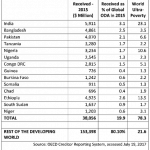How ‘Designing Under the Mango Tree’ Can Prevent Digital Solution Hiccups
Imagine if cars were only designed and tested to run on the smoothest roads? What would happen on a road trip in rural Africa? The car would break down, of course. Fortunately, we have automotive solutions to help us get across almost any terrain. But we don’t have similar solutions when it comes to the software that we use in development programs in remote rural areas.
Out beyond internet coverage, a data error can lose you and your team half a day traveling back to connectivity to solve the problem. All too often, the underlying problem is that the program was built for California, not Cotonou. It was created in a connected environment where developers just stepped outside of their office, turned off their data plan to check the solution, and called it a day. Put simply, the solution was not designed for the end user, AKA: the development practitioner out in the field, far from any help desk.
Like an off-road vehicle, when you build a digital solution, you want to build with the most challenging environments in mind. Why? So the digital solution can go to scale with fewer hiccups, as it grows outward. “Designing under the mango tree” is a term Dimagi coined that illustrates this point. Dimagi is for-profit B Corp based in Boston that is focused on last-mile solutions, including its CommCare technology, an open-source mobile data collection platform.
“Designing under the mango tree” requires working in partnership with a variety of end users. True partnership takes a lot of work. If you want to have good digital solution that is designed to work in the field, you must constantly make changes, understand the goal and think about sustainability from the beginning.
A good lesson in this comes from Neal Lesh, chief strategy officer at Dimagi, who recalls 2010, when funding from the USAID Development Innovations Venture allowed them to expand CommCare, Dimagi’s mobile data collection platform, to multiple partners for the first time. Dimagi offered 10 free mobile phones, and the group’s time and resources to any organization that would adopt CommCare on a project.
“We worked with 11 partners on proof of concepts with 10 users each in rural India. It was fast and furious,” Lesh said. “Then we met with Marianna Hensley, a Catholic Relief Services (CRS) program manager in India. That was a turning point. She said, ‘Wait, let’s get the content right.’ She took her time and really made us understand the goals of the project and where it was being used.”
Dimagi took the content from CRS’ Reducing Maternal and Newborn Death (ReMiND) project that used the CommCare platform and shared it with other nonprofits. Save the Children, for example, would have an idea and there would be a back-and-forth on content, questions and branching logic. This came to be known as “emergent collaboration.”
“Working with Mariana set the culture of sharing,” Lesh recalled. “If she shared, then the other organizations would share back.”
Previous experience in Afghanistan had taught Dimagi that the program needed to be designed for illiterate users. So voice recording and images were added. The CRS’ ReMiND project helped test this, and immediately community health workers began showing the phone to clients who then started looking and listening to the recordings. The whole interaction changed.
“This was a turning point for CommCare,” Lesh said. “It was confusing at first, as it took us a while to grasp the educational potential for our technology. But now it is clear this is a core part of what we do, and our apps are beautiful.”
A cultural Shift takes time
One early lesson Dimagi learned was that when partners adopt a mobile data collection solution like CommCare for the first time, they are radically changing how they approach and use data at their organization. This cultural shift takes time and it is imperative that an organization understands the different stages of this process. Dimagi created the Maturity Model to identify these stages and to help its partners measure and set project expectations.
The Maturity Model includes a survey used to assess the maturity of an organization’s mobile solution across five levels of maturity – from proof of concept to scale. The Maturity Model helps organizations identify barriers and offers a clear roadmap to achieving scale. It’s important to note that each maturity stage takes time – a partner cannot move up more than one or two notches on each intervention in a year. It might take an organization two or three years before they end up where they want to be.
As an organization moves through these levels of maturity, Dimagi keeps the partnership dialogue open to learn and continuously improve CommCare. Since CommCare is a platform-based mobile solution, each time Dimagi’s team of 20-plus developers makes a change, all projects using CommCare benefit from the updates.
What’s ahead for this partnership process?
This list will change as the partnership grows. Lesh’s dream is to continuously improve the user experience throughout the project to create a dynamic system that constantly improves the experience for the user and the client.
“We want ongoing feedback for constant improvement,” Lesh said.
This is a major change in thinking for development practitioners with five-year funding, who want to test a fixed set of indicators throughout the project. If development practitioners want a real change, donors should measure projects on the ability to successfully hand the whole digital collection process over to the national implementation team during the project cycle.
CRS is now rolling out CommCare as a globally supported solution for digital data collection. And partnership was the key.
Kathryn M. Clifton is the ICT4D knowledge management and communications specialist for Catholic Relief Services.
Photo: CRS staff, India ReMiND project
- Categories
- Social Enterprise, Technology
- Tags
- data, partnerships, product design



